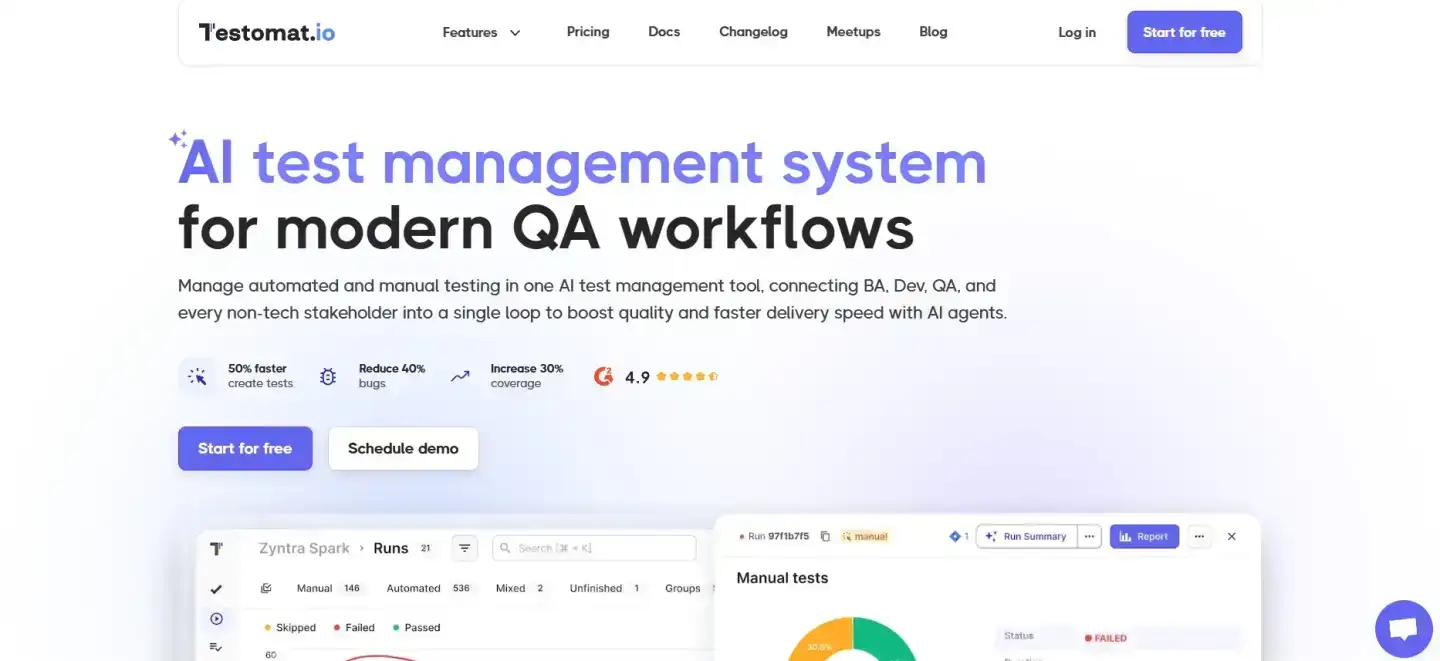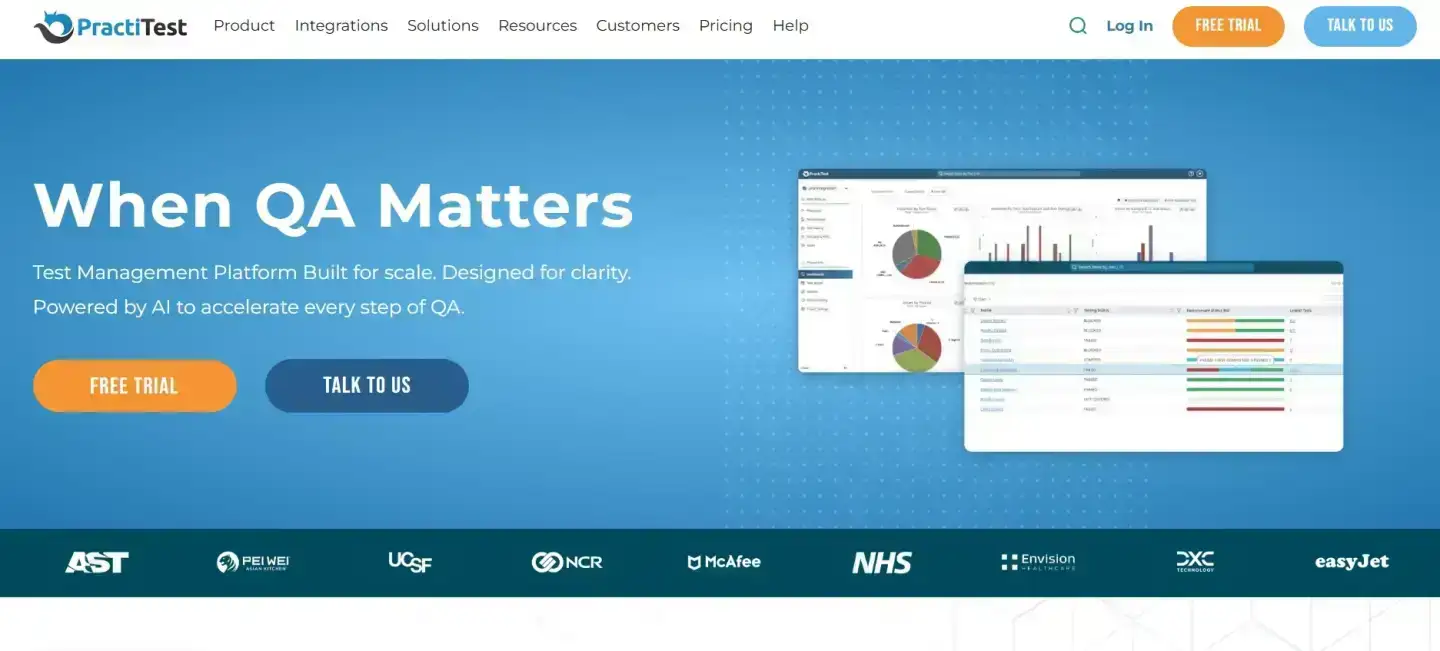Jira is an excellent project and issue tracking tool, but it lacks comprehensive test case management features for QA teams. To effectively manage testing in Jira – including writing test cases, tracking execution, and logging defects – organizations turn to dedicated test management tools for Jira. These Jira testing tools come either as plugins that live inside Jira or as standalone test management software that integrate seamlessly with Jira. Below we review some of the best Jira test management tools available, covering both Jira add-ons and external platforms, to help you manage testing more efficiently.
1. Testomat.io

Testomat.io is a modern, AI-powered test management platform built for Agile teams. It supports both manual and automated testing in one place, with robust integrations and analytics. Notably, Testomat.io integrates seamlessly with Jira (Cloud, Server, and Data Center) for real-time two-way syncing of test cases, defects, and results. This means testers can automate Jira issue creation for failed tests and keep test results in sync without leaving Testomat.
The tool also offers BDD support (behavior-driven development) for Gherkin test scenarios and synchronizes with popular automation frameworks like Selenium, Cypress, and Playwright. Testomat.io provides rich reporting dashboards (including real-time test run analytics and coverage heatmaps) and even includes AI-assisted test generation to speed up test design. A free plan is available for small teams, with paid plans for scaling up, making Testomat.io a highly flexible Jira test management solution for teams seeking cutting-edge features.
2. TestRail

TestRail is a long-established test case management tool widely used by QA teams, and it offers robust integration with Jira. TestRail lets you manage large repositories of test cases, organize them into test plans and suites, and track execution with detailed reporting. When linked with Jira, you can associate test results with Jira issues and requirements for traceability.
TestRail provides features like milestone-based test planning, configurable dashboards for progress tracking, and support for both manual and automated test runs. Many teams integrate automated testing results into TestRail via its APIs, while using the Jira add-on to view test execution status within Jira. TestRail’s combination of comprehensive test management functionality and Jira integration makes it suitable for enterprise environments that require rigorous documentation and reporting.
3. Xray for Jira

Xray is a popular test management app that is fully embedded within Jira. It treats test cases, test plans, and test executions as native Jira issue types, enabling QA and development to work in one unified platform. With Xray, teams can manage manual testing and BDD scenarios (using Gherkin) directly in Jira, and automate test result uploads via REST API or CI/CD integrations.
Xray provides end-to-end traceability: requirements, tests, and defects are all linked in Jira for complete coverage visibility. Testers can organize tests in folders or test sets and monitor testing progress on Jira dashboards. This Jira-native test management approach means no context-switching – all testing artifacts live inside Jira. Xray is ideal for teams that want to leverage Jira as an all-in-one testing tool, with the ability to customize workflows and issue fields for testing needs. It’s a scalable solution (available for Cloud, Server, Data Center) and often praised for keeping testing and development tightly aligned in Agile projects.
4. Qase

Qase is a modern cloud-based test management tool known for its intuitive interface and powerful integrations. It offers a full range of test management features – from test case design and parameterization to test runs and defect reporting – packaged in a user-friendly SaaS platform. Qase has a two-way Jira integration that allows teams to link test cases to Jira issues and automatically create Jira bugs from failed test runs.
This ensures development and QA stay in sync without manual copy-paste of bug reports. Qase also provides real-time dashboards and reports, a robust API, and integrations with tools like Selenium, Jenkins, GitHub, Slack and even Postman for API testing. Teams often highlight Qase’s quick onboarding and customizable fields which let you tailor the test management workflow to your needs. With a generous free plan and affordable pricing, Qase is a strong Jira test management software option for teams seeking a lightweight yet capable solution outside of Jira.
5. Zephyr

Zephyr is a family of test management apps designed specifically for Jira, acquired by SmartBear. Zephyr allows you to create and manage test cases directly inside Jira projects, making Jira a central hub for both development and testing. There are two main editions: Zephyr Squad (formerly Zephyr for Jira) for small to mid-sized teams, and Zephyr Scale for enterprise-scale testing with advanced features.
Using Zephyr, testers can plan test cycles, execute tests (manual or automated via integrations), and track results with customizable dashboards – all within Jira’s interface. It provides end-to-end traceability between user stories, test cases, and defects, so you can easily see testing coverage for any Jira issue. Zephyr supports BDD with Cucumber for behavior-driven testing, and integrates with CI tools like Jenkins or Bamboo to import automation results. Because it is Jira-native, Zephyr eliminates the need to juggle separate systems; many Agile teams favor it to simplify test management in Jira with minimal overhead. If your team wants to manage testing entirely inside Jira, Zephyr is one of the top Jira plugins for test management.
6. Testiny

Testiny is a newer entrant that offers test management for Jira with a focus on simplicity and cloud accessibility. It provides an easy-to-use web interface where you can create test cases (using templates or in bulk), organize them in folders, and set up test runs with just a few clicks. Testiny also consolidates automated test results from your CI/CD pipelines, giving you a unified view of manual and automated testing.
The standout feature of Testiny is its two-way Jira integration: you can link test cases to Jira requirements and automatically submit issues to Jira when a test fails, ensuring quick feedback to developers. Conversely, within Jira you can view testing status linked to user stories, which improves collaboration between QA and dev. Testiny provides real-time metrics and reports (including professional PDF export) so teams can monitor testing progress and quality trends. It also supports multiple issue trackers (like Azure DevOps, GitHub, etc.), but it’s especially well-suited for Jira users. With a free plan for small teams (up to 3 users) and on-premise deployment options for enterprises, Testiny is a flexible new Jira test management tool to consider, particularly for teams that value a clean UI and seamless Jira syncing.
7. PractiTest

PractiTest is a SaaS end-to-end test management solution known for its advanced capabilities and two-way integrations. For Jira users, PractiTest offers a real-time 2-way integration that keeps requirements, tests, and defects fully synchronized between the two systems. QA teams can author test cases and test cycles in PractiTest, link them to Jira user stories or requirements, and any updates or bug submissions will automatically reflect in Jira (and vice versa). This provides full traceability and ensures everyone is working with the latest testing status.
PractiTest supports rich test organization (with hierarchical suites), robust reporting and customizable dashboards (mixing data from both PractiTest and Jira), and even AI-powered features to help optimize your test suite. It also integrates with automation frameworks and CI pipelines, acting as a central QA hub that connects to Jira and other tools in your stack. PractiTest is favored by many enterprise and regulated teams because of its reliability, security, and extensive feature set. While it resides outside Jira, its Jira test management integration ensures you still get a unified workflow. For teams that need an all-in-one QA management platform with strong Jira connectivity, PractiTest is a top contender.
Conclusion
Choosing the right test management tool for Jira will depend on your team’s needs and workflow. Jira-centric solutions like Xray or Zephyr keep everything inside Jira for convenience, whereas external platforms like Testomat.io, TestRail, Qase, Testiny, or PractiTest offer additional features, scalability, or flexibility while still integrating with Jira.
There is no one-size-fits-all solution – each tool has strengths catering to different use cases. Key considerations include how deeply you need Jira integration, the level of reporting/analytics desired, support for automation or BDD, ease of use, and budget. By evaluating these Jira test management tools against your requirements, you can find the best fit to streamline your QA process and enhance software quality. With the proper test management in place, Jira can effectively become a single source of truth for both development and testing, leading to better collaboration and faster release cycles.









